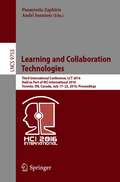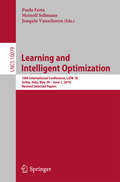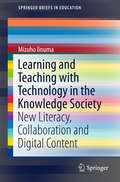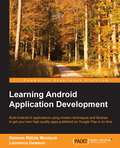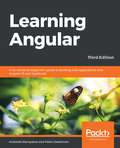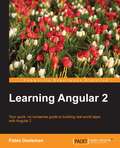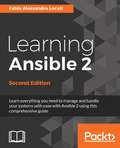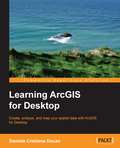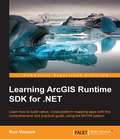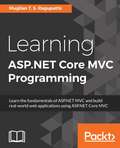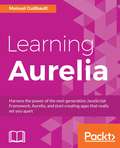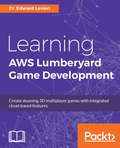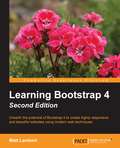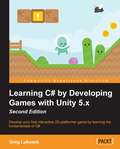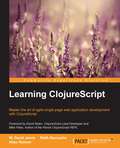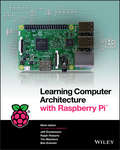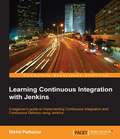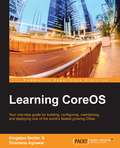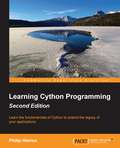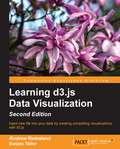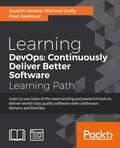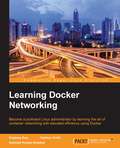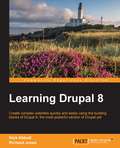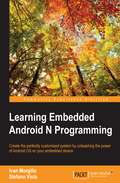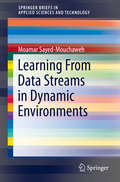- Table View
- List View
Learning and Collaboration Technologies: Third International Conference, LCT 2016, Held as Part of HCI International 2016, Toronto, ON, Canada, July 17-22, 2016, Proceedings (Lecture Notes in Computer Science #9753)
by Panayiotis Zaphiris Andri IoannouThis book constitutes the refereed proceedings of the Third International Conference on Learning and Collaboration Technologies, LCT 2016, held as part of the 18th International Conference on Human-Computer Interaction, HCII 2016, in Toronto, Canada, in July 2016, in conjunction with 14 thematically similar conferences. The 1287 papers presented at the HCII 2016 conferences were carefully reviewed and selected from 4354 submissions. The papers cover the entire field of human-computer interaction, addressing major advances in knowledge and effective use of computers in a variety of application areas. The papers included in this volume are organized in the following thematic sections: instructional design; interaction techniques and platforms for learning; learning performance; web-based, mobile and ubiquitous learning; intelligent learning environments; learning technologies; collaboration technologies; and cultural and social aspects of learning and collaboration technologies.
Learning and Intelligent Optimization
by Paola Festa Meinolf Sellmann Joaquin VanschorenThis book constitutes the thoroughly refereed post-conference proceedings of the 10th International Conference on Learning and Optimization, LION 10, which was held on Ischia, Italy, in May/June 2016. The 14 full papers presented together with 9 short papers and 2 GENOPT papers were carefully reviewed and selected from 47 submissions. The papers address all fields between machine learning, artificial intelligence, mathematical programming and algorithms for hard optimization problems. Special focus is given to new ideas and methods; challenges and opportunities in various application areas; general trends, and specific developments.
Learning and Teaching with Technology in the Knowledge Society
by Mizuho IinumaThis book discusses learning and teaching with modern technology in the new knowledge society. It focuses specifically on new literacy and technology in classroom environments. Based on a social-constructivist approach, this book covers a wide range of new technology use examples, such as participatory media, video recording systems and 3D computer graphics. A case study on a constructivist approach to teaching and learning, especially CSCL (computer supported collaborative learning), is discussed from a practical perspective for educators. It also includes specific in-class practices with detailed accounts of curricula featuring readily accessible yet new technology available for classroom use, such as Google Sketchup 3D computer models.
Learning Android Application Development
by Raimon Rafols Montane Laurence DawsonBuild Android N applications using modern techniques and libraries to get your own high-quality apps published on Google Play in no time About This Book * Get started with Android development, from the installation of required tools to publishing to the market * Make your applications Android N ready--Android has evolved quite a lot since the very beginning and so has their Software Development Kit--so get up to speed * Save time and improve the quality of your applications with widely used open source libraries and dependency management Who This Book Is For Want to get started with Android development? Start here. What You Will Learn * Get to know how to use popular open source libraries to reduce time to market and avoid re-inventing the wheel * Automate your application's testing phase to avoid last minute crashes * Use dependency management to properly keep dependencies and updates under control * Efficiently show huge amounts of items in a list * Forget about memory and speed concerns * Publish and monetize your Android applications on Google Play * Persist your application data so it can continue working in offline mode * Don't let the UX break because of network issues In Detail The mobile app market is huge. But where do you start? And how you can deliver something that takes Google Play by storm? This guide is the perfect route into Android app development - while it's easy for new apps to sink without a trace, we'll give you the best chance of success with practical and actionable guidance that will unlock your creativity and help you put the principles of Android development into practice. From the fundamentals and getting your project started to publishing your app to a huge market of potential customers, follow this guide to become a confident, creative and reliable mobile developer. Get to grips with new components in Android 7 such as RecyclerView, and find out how to take advantage of automated testing, and, of course, much, much more. What are you waiting for? There's never been a better time - or a better way - to get into Android app development. Style and approach More than just a manual, this is an accessible route into Android development. Packed with examples that demonstrate how to put key concepts and ideas into practice, this guide isn't just about learning, it's about immediate development.
Learning Angular: A no-nonsense beginner's guide to building web applications with Angular 10 and TypeScript, 3rd Edition
by Aristeidis Bampakos Pablo DeelemanUncover Angular's potential for creating enterprise web applications—from setting up the environment to deployment—with the help of expert guidance, step-by-step explanations, and hands-on exercises Key Features Learn the fundamentals of Angular to build web applications using TypeScript Explore the basics of Angular development, from components and templates to forms and services Discover best practices for building, packaging, and testing Angular applications Book Description Angular, loved by millions of web developers around the world, continues to be one of the top JavaScript frameworks thanks to its regular updates and new features that enable fast, cross-platform, and secure frontend web development. With Angular, you can achieve high performance using the latest web techniques and extensive integration with web tools and integrated development environments (IDEs). Updated to Angular 10, this third edition of the Learning Angular book covers new features and modern web development practices to address the current frontend web development landscape. If you are new to Angular, this book will give you a comprehensive introduction to help you get you up and running in no time. You'll learn how to develop apps by harnessing the power of the Angular command-line interface (CLI), write unit tests, style your apps by following the Material Design guidelines, and finally deploy them to a hosting provider. The book is especially useful for beginners to get to grips with the bare bones of the framework needed to start developing Angular apps. By the end of this book, you'll not only be able to create Angular applications with TypeScript from scratch but also enhance your coding skills with best practices. What you will learn Use the Angular CLI to scaffold, build, and deploy a new Angular application Build components, the basic building blocks of an Angular application Discover techniques to make Angular components interact with each other Understand the different types of templates supported by Angular Create HTTP data services to access APIs and provide data to components Enhance your application's UX with Angular Material Apply best practices and coding conventions to your large-scale web development projects Who this book is for The Angular TypeScript book is for JavaScript and full-stack developers who want to enter the world of frontend development with Angular or migrate to the Angular framework to build professional web applications. Familiarity with web and programming concepts will assist with understanding the content covered in the book.
Learning Angular 2
by Pablo DeelemanYour quick, no-nonsense guide to building real-world apps with Angular 2 About This Book * The first and best overview of Angular 2 on the market--this guide gathers together everything there is to know about Angular 2 and groups it into intuitive sections. * This book is your detailed map of every feature and its use cases. * The author has done all the hard work of fitting everything Angular 2 means for developers together for you, making this book the quickest way to learn Angular 2 from scratch. Who This Book Is For This book is targeted at web developers who want to build the next generation of state-of-the-art mobile and desktop web applications with Angular 2. This book does not require you to have prior exposure to either Angular 1.x or 2, although comprehensive knowledge of JavaScript is assumed. It's great for newcomers to Angular who learn best through clear explanations and definitions of concepts. What You Will Learn * Set up your working environment in order to have all the tools you need to start building Angular 2 components with minimum effort * Get up to speed with TypeScript, a powerful typed superset of JavaScript that compiles to plain JavaScript * Take full control of how your data is rendered and updated upon data changes * Build powerful web applications based on structured component hierarchies that emit and listen to events and data changes throughout the elements tree * Explore how to consume external APIs and data services and allow data editing by harnessing the power of web forms made with Angular 2 * Deliver seamless web navigation experiences with application routing and state handling common features with ease * Discover how to bulletproof your applications by introducing smart unit testing techniques and debugging tools In Detail Angular 2 was conceived as a complete rewrite in order to fulfill the expectations of modern developers who demand blazing fast performance and responsiveness from their web applications. This book will help you learn the basics of how to design and build Angular 2 components right from the beginning, providing full coverage of the TypeScript syntax required to follow the examples included. From that point on, we will build upon our first components, interconnect them, and give shape to larger web applications. We will then move to implementing routing in Angular 2, analyzing how to handle application states, and navigating from one component to another in depth. After this, the book features full coverage of web forms and user input validation, later leveraging all of this information to go through the basics of implementing user authentication in Angular 2 and providing a bird's eye view of the different strategies at hand to secure pages and areas of your website. Animating components and DOM elements with Angular 2 is also covered in this book. The final part of this book provides broad insights into how to unit test components and other modules such as services, directives, routes or pipes. Style and approach This book covers everything there is to know about getting well-acquainted with Angular without bogging you down. Everything is neatly laid out under clear headings for quick consultation, offering you the information required to understand a concept immediately, with short relevant examples of each feature.
Learning Ansible 2 - Second Edition
by Fabio Alessandro LocatiLearn everything you need to manage and handle your systems with ease with Ansible 2 using this comprehensive guide About This Book * Simplify the automation of applications and systems using the newest version of Ansible * Get acquainted with fundamentals of Ansible such as playbooks, modules, and various testing strategies * A comprehensive, learning guide that provides you with great skills to automate your organization's infrastructure using Ansible 2 Who This Book Is For The book is for sys admins who want to automate their organization's infrastructure using Ansible 2. No prior knowledge of Ansible is required. What You Will Learn * Set up Ansible 2 and an Ansible 2 project in a future-proof way * Perform basic operations with Ansible 2 such as creating, copying, moving, changing, and deleting files, and creating and deleting users * Deploy complete cloud environments using Ansible 2 on AWS and DigitalOcean * Explore complex operations with Ansible 2 (Ansible vault, e-mails, and Nagios) * Develop and test Ansible playbooks * Write a custom module and test it In Detail Ansible is an open source automation platform that assists organizations with tasks such as configuration management, application deployment, orchestration, and task automation. With Ansible, even complex tasks can be handled easier than before. In this book, you will learn about the fundamentals and practical aspects of Ansible 2 by diving deeply into topics such as installation (Linux, BSD, and Windows Support), playbooks, modules, various testing strategies, provisioning, deployment, and orchestration. In this book, you will get accustomed with the new features of Ansible 2 such as cleaner architecture, task blocks, playbook parsing, new execution strategy plugins, and modules. You will also learn how to integrate Ansible with cloud platforms such as AWS. The book ends with the enterprise versions of Ansible, Ansible Tower and Ansible Galaxy, where you will learn to interact Ansible with different OSes to speed up your work to previously unseen levels By the end of the book, you'll able to leverage the Ansible parameters to create expeditious tasks for your organization by implementing the Ansible 2 techniques and paradigms. Style and approach This book is a step-by-step learning guide on the all new Ansible 2, which is an ideal configuration management tool.
Learning ArcGIS for Desktop
by Daniela Cristiana DocanCreate, analyze, and map your spatial data with ArcGIS for Desktop About This Book * Learn how to use ArcGIS for Desktop to create and manage geographic data, perform vector and raster analysis, design maps, and share your results * Solve real-world problems and share your valuable results using the powerful instruments of ArcGIS for Desktop * Step-by-step tutorials cover the main editing, analyzing, and mapping tools in ArcGIS for Desktop Who This Book Is For This book is ideal for those who want to learn how to use the most important component of Esri's ArcGIS platform, ArcGIS for Desktop. It would be helpful to have a bit of familiarity with the basic concepts of GIS. Even if you have no prior GIS experience, this book will get you up and running quickly. What You Will Learn * Understand the functionality of ArcGIS for Desktop applications * Explore coordinate reference system concepts and work with different map projections * Create, populate, and document a file geodatabase * Manage, create, and edit feature shapes and attributes * Built automate analysis workfl ows with ModelBuilder * Apply basic principles of map design to create good-looking maps * Analyze raster and three-dimensional data with the Spatial Analyst and 3D Analyst extensions In Detail ArcGIS for Desktop is one of the main components of the ESRI ArcGIS platform used to support decision making and solve real-world mapping problems. Learning ArcGIS for Desktop is a tutorial-based guide that provides a practical experience for those who are interested in start working with ArcGIS. The first five chapters cover the basic concepts of working with the File Geodatabase, as well as editing and symbolizing geospatial data. Then, the book focuses on planning and performing spatial analysis on vector and raster data using the geoprocessing and modeling tools. Finally, the basic principles of cartography design will be used to create a quality map that presents the information that resulted from the spatial analysis previously performed. To keep you learning throughout the chapters, all exercises have partial and final results stored in the dataset that accompanies the book. Finally, the book offers more than it promises by using the ArcGIS Online component in the tutorials as source of background data and for results sharing Style and approach This easy-to-follow guide is full of hands-on exercises that use open and free geospatial datasets. The basic features of the ArcGIS for Desktop are explained in a step-by-step style.
Learning ArcGIS Runtime SDK for .NET
by Ron VincentThis book is for .NET developers who want to learn to build native Geographic Information System (GIS) application.
Learning ASP.NET MVC Programming
by Mugilan T. RagupathiThis book is for developers who want to learn to build web applications using ASP.Net MVC 6, developers who want to make a career building web applications using Microsoft technology, and developers who are working in Ruby on Rails or other web frameworks and want to learn ASP.Net MVC6. No knowledge of the ASP.Net platform or the .Net platform is required. Even though you do not need to have experience in C#, an understanding of the basic constructs (loops, conditionals, classes, and objects) of any modern programming language would be helpful.
Learning Aurelia
by Manuel GuilbaultHarness the power of the next-generation JavaScript Framework, Aurelia, and start creating apps that really set you apart About This Book • Develop well-designed, decoupled, and testable single-page applications with Aurelia • Leverage the latest web standards to increase code performance, readability, and cross-compatibility • Understand how Aurelia is organized and use its innovative MVC approach to design professional-quality web apps Who This Book Is For This book is for JavaScript developers who want to build modern web apps with Aurelia. No prior knowledge of Aurelia is needed. What You Will Learn • Build a modern single-page web application • Understand the workflow of an Aurelia application • Design reusable web components, which can be shared and integrated into various frameworks and libraries • Write clean, modular, and testable code that will be easy to maintain and evolve • Use all the latest–and even future–web standards, so the application gathers minimal technical debt In Detail Aurelia is one of the most promising new JavaScript frameworks for mobile, desktop, and web, which makes developing powerful, modern web applications a straightforward task. Its power lies in its simplicity and clear workflow that enables developers to build next-generations apps for the web with ease. From initial structuring to full deployment, this book will serve as a step-by-step guide to develop a modern web application from scratch with the Aurelia framework. In addition to including a comprehensive coverage of various Aurelia framework features, this book will also show you how to utilize these features in the real world to develop a professional single-page web application. You'll see how to make the most out of Aurelia by understanding the Aurelia workflow and then applying it in real-world development tasks. By the end of the book, you will have learned to develop a clean and maintainable application in Aurelia from scratch. Style and approach This book will show you how to leverage the cutting edge features of Aurelia framework to develop modern web apps with a clear workflow. Using the modern architecture and features of Aurelia, this book will demonstrate the development of a web application from scratch.
Learning AWS Lumberyard Game Development
by Dr Edward LavieriCreate stunning 3D multiplayer games with integrated cloud-based features About This Book * Build a multiplayer 3D game from scratch using the features of Amazon's Lumberyard * Explore the world of Lumberyard along with Twitch and various key Amazon Web Services to build a game * This step-by-step practical guide will teach you how to build cross-platform games using Lumberyard Who This Book Is For The book caters for those who have an interest or desire to create their own games, either as a hobbyist or to enhance their skills as a professional games developer. The book requires previous knowledge of software development. Experience with C++ will also be beneficial. What You Will Learn * Explore Lumberyard's graphical user interface * Create stunning game worlds * Use Geppetto editor to create 3D characters * Create and animate game characters using Lumberyard's toolset * Create impressive gameplay to add multiplayer functionality to your game * Debug and play your 3D game * Add multiplayer functionality to your game using Amazon GameLift * Integrate with Amazon cloud services to support cloud computing and storage * Engage your users during gameplay with Twitch In Detail Amazon's Lumberyard is a 3D cross-platform game development engine for building high-quality AAA games. It makes the process of creating multi-player games and adding realistic characters, stunning terrains, and special effects much faster and more efficient. This book will show you how to use Lumberyard to create a multiplayer 3D game with cloud computing, storage, and Twitch integration for user engagement. We will start with an introduction to Lumberyard and provide an overview of its capabilities and integration options. Once the game engine is installed, we'll guide you through the creation of an immersive game world with characters. You'll add animations and audio to bring the game to life. We'll explore external interactions to support live multiplayer game play, data storage, user engagement, and the back end. By the end of the book, you will be efficient in building cross-platform games using Lumberyard. Style and approach This step-by-step tutorial is filled with practical examples that will introduce you to the game engine's interface, as well as setting up your development environment.
Learning Bootstrap 4 - Second Edition
by Matt LambertUnearth the potential of Bootstrap 4 to create highly responsive and beautiful websites using modern web techniques About This Book * This book shows how to take advantage of the all new features introduced in Bootstrap * Learn responsive web design and discover how to build mobile-ready websites with ease * Find out how to extend the capabilities of Bootstrap with a huge range of tools and plugins, including jQuery, * Do more with JavaScript and learn how to create an enhanced user experience Who This Book Is For If you want to learn to build enterprise-level websites efficiently with Bootstrap, this book is for you. You must have a basic and fundamental understanding of HTML, CSS, and JavaScript; however, there is no need to have prior Bootstrap experience. What You Will Learn * Fire up Bootstrap and set up the required build tools to get started * See how and when to use Flexbox with the Bootstrap layouts * Find out how to make your websites responsive, keeping in mind Mobile First design * Work with content such as tables and figures * Play around with the huge variety of components that Bootstrap offers * Extend your build using plugins developed from JavaScript * Use Sass to customize your existing themes In Detail Bootstrap, the most popular front-end framework built to design elegant, powerful, and responsive interfaces for professional-level web pages has undergone a major overhaul. Bootstrap 4 introduces a wide range of new features that make front-end web design even simpler and exciting. In this gentle and comprehensive book, we'll teach you everything that you need to know to start building websites with Bootstrap 4 in a practical way. You'll learn about build tools such as Node, Grunt, and many others. You'll also discover the principles of mobile-first design in order to ensure your pages can fit any screen size and meet the responsive requirements. Learn to play with Bootstrap's grid system and base CSS to ensure your designs are robust and that your development process is speedy and efficient. Then, you'll find out how you can extend your current build with some cool JavaScript Plugins, and throw in some Sass to spice things up and customize your themes. This book will make sure you're geared up and ready to build amazingly beautiful and responsive websites in a jiffy. Style and approach With the help of several real-world examples and code, this book will teach you to build a full-featured responsive website in Bootstrap, which is mobile-ready.
Learning C# by Developing Games with Unity 5.x - Second Edition
by Greg LukosekDevelop your first interactive 2D platformer game by learning the fundamentals of C# About This Book * Get to grips with the fundamentals of scripting in C# with Unity * Create an awesome, 2D platformer game from scratch using the principles of object-oriented programming and coding in C# * This is a step-by-step guide to learn the fundamentals of C# scripting to develop GameObjects and master the basics of the new UI system in Unity Who This Book Is For The book is targeted at beginner level Unity developers with no programming experience. If you are a Unity developer and you wish to learn how to write C# scripts and code by creating games, then this book is for you. What You Will Learn * Understand the fundamentals of variables, methods, and code syntax in C# * Get to know about techniques to turn your game idea into working project * Use loops and collections efficiently in Unity to reduce the amount of code * Develop a game using the object-oriented programming principles * Generate infinite levels for your game * Create and code a good-looking functional UI system for your game * Publish and share your game with users In Detail Unity is a cross-platform game engine that is used to develop 2D and 3D video games. Unity 5 is the latest version, released in March 2015, and adds a real-time global illumination to the games, and its powerful new features help to improve a game's efficiency. This book will get you started with programming behaviors in C# so you can create 2D games in Unity. You will begin by installing Unity and learning about its features, followed by creating a C# script. We will then deal with topics such as unity scripting for you to understand how codes work so you can create and use C# variables and methods. Moving forward, you will find out how to create, store, and retrieve data from collection of objects. You will also develop an understanding of loops and their use, and you'll perform object-oriented programming. This will help you to turn your idea into a ready-to-code project and set up a Unity project for production. Finally, you will discover how to create the GameManager class to manage the game play loop, generate game levels, and develop a simple UI for the game. By the end of this book, you will have mastered the art of applying C# in Unity. Style and approach This is a step-by-step guide to developing a game from scratch by applying the fundamentals of C# and Unity scripting.
Learning ClojureScript
by W. David Jarvis Rafik Naccache Allen RohnerMaster the art of agile single page web application development with ClojureScript About This Book * Set up interactive development workflows for the browser or Node.js thanks to the ClojureScript ecosystem * Learn the basics of interactive single page web app development taking advantage of the functional nature of ClojureScript * Delve into advanced rich web application development concepts such as Om, along with core.async, using zippers and logic programming, and preparing code for production with testing or optimizing via the Google Closure Compiler Who This Book Is For This book is for web application developers who want to benefit from the power of ClojureScript to get an agile and highly productive development platform that targets mainly browser JavaScript. You are not required to be fluent in Clojure, but it will be easier for you if you have a basic understanding of browser and server-side JavaScript. What You Will Learn * Understand how the ClojureScript compiler operates * Set up interactive development workflows for ClojureScript * Grasp the basics of the ClojureScript language, including basic syntax, data structures, variable scoping, namespaces, and finally the powerful sequence abstraction * Delve into advanced concepts such as functional programming, macro writing, asynchronous programming, app routing, and real-time web * Develop simple one page web applications * Explore techniques to make your web apps aware of the external world through external or embedded database access or Oauth 2 integration * Learn more advanced ClojureScript concepts like in app routing, real-time web * Prepare your work for production, getting insights into optional type-checking, writing portable Clojure/ClojureScript code, and testing In Detail Clojure is an expressive language that makes it possible to easily tackle complex software development challenges. Its bias toward interactive development has made it a powerful tool, enabling high developer productivity. In this book, you will first learn how to construct an interactive development experience for ClojureScript.. You will be guided through ClojureScript language concepts, looking at the basics first, then being introduced to advanced concepts such as functional programming or macro writing. After that, we elaborate on the subject of single page web applications, showcasing how to build a simple one, then covering different possible enhancements. We move on to study more advanced ClojureScript concepts, where you will be shown how to address some complex algorithmic cases. Finally, you'll learn about optional type-checking for your programs, how you can write portable code, test it, and put the advanced compilation mode of the Google Closure Compiler to good use. Style and approach This book is a comprehensive reference guide on ClojureScript development for the front end, and will gradually help you master interactive ClojureScript development workflows, through detailed step-by-step information illustrated with annotated code samples.
Learning Computer Architecture with Raspberry Pi
by Eben Upton Jeffrey Duntemann Ralph Roberts Tim Mamtora Ben EverardUse your Raspberry Pi to get smart about computing fundamentals In the 1980s, the tech revolution was kickstarted by a flood of relatively inexpensive, highly programmable computers like the Commodore. Now, a second revolution in computing is beginning with the Raspberry Pi. Learning Computer Architecture with the Raspberry Pi is the premier guide to understanding the components of the most exciting tech product available. Thanks to this book, every Raspberry Pi owner can understand how the computer works and how to access all of its hardware and software capabilities. Now, students, hackers, and casual users alike can discover how computers work with Learning Computer Architecture with the Raspberry Pi. This book explains what each and every hardware component does, how they relate to one another, and how they correspond to the components of other computing systems. You'll also learn how programming works and how the operating system relates to the Raspberry Pi's physical components. Co-authored by Eben Upton, one of the creators of the Raspberry Pi, this is a companion volume to the Raspberry Pi User Guide An affordable solution for learning about computer system design considerations and experimenting with low-level programming Understandable descriptions of the functions of memory storage, Ethernet, cameras, processors, and more Gain knowledge of computer design and operation in general by exploring the basic structure of the Raspberry Pi The Raspberry Pi was created to bring forth a new generation of computer scientists, developers, and architects who understand the inner workings of the computers that have become essential to our daily lives. Learning Computer Architecture with the Raspberry Pi is your gateway to the world of computer system design.
Learning Continuous Integration with Jenkins
by Nikhil PathaniaA beginner's guide to implementing Continuous Integration and Continuous Delivery using Jenkins About This Book * Speed up and increase software productivity and software delivery using Jenkins * Automate your build, integration, release, and deployment processes with Jenkins--and learn how continuous integration (CI) can save you time and money * Explore the power of continuous delivery using Jenkins through powerful real-life examples Who This Book Is For This book is for anyone who wants to exploit the power of Jenkins. This book servers a great starting point for those who are in the field DevOps and would like to leverage the benefits of CI and continuous delivery in order to increase productivity and reduce delivery time. What You Will Learn * Take advantage of a continuous delivery solution to achieve faster software delivery * Speed up productivity using a continuous Integration solution through Jenkins * Understand the concepts of CI and continuous delivery * Orchestrate many DevOps tools using Jenkins to automate builds, releases, deployment, and testing * Explore the various features of Jenkins that make DevOps activities a piece of cake * Configure multiple build machines in Jenkins to maintain load balancing * Manage users, projects, and permissions in Jenkins to ensure better security * Leverage the power of plugins in Jenkins In Detail In past few years, Agile software development has seen tremendous growth across the world. There is huge demand for software delivery solutions that are fast yet flexible to frequent amendments. As a result, CI and continuous delivery methodologies are gaining popularity. Jenkins' core functionality and flexibility allows it to fit in a variety of environments and can help streamline the development process for all stakeholders. This book starts off by explaining the concepts of CI and its significance in the Agile world with a whole chapter dedicated to it. Next, you'll learn to configure and set up Jenkins. You'll gain a foothold in implementing CI and continuous delivery methods. We dive into the various features offered by Jenkins one by one exploiting them for CI. After that, you'll find out how to use the built-in pipeline feature of Jenkins. You'll see how to integrate Jenkins with code analysis tools and test automation tools in order to achieve continuous delivery. Next, you'll be introduced to continuous deployment and learn to achieve it using Jenkins. Through this book's wealth of best practices and real-world tips, you'll discover how easy it is to implement a CI service with Jenkins. Style and approach This is a step-by-step guide to setting up a CI and continuous delivery system loaded with hands-on examples
Learning CoreOS
by Kingston Smiler. S Shantanu AgrawalYour one-stop guide for building, configuring, maintaining, and deploying one of the world's fastest growing OSes About This Book * Understand the features of CoreOS and learn to administrate and secure a CoreOS environment * Develop, test, and deploy cloud services and applications more quickly and efficiently inside lightweight containers using CoreOS * This is a complete tutorial on CoreOS, which is the preferred OS for cloud computing as it contains components that facilitate cloud management Who This Book Is For This book is for cloud or enterprise administrators and application developers who would like to gain knowledge about CoreOS to deploy a cloud application or micro-services on a cluster of cloud servers. It is also aimed at administrators with basic networking experience. You do not need to have any knowledge of CoreOS. What You Will Learn * Understand the benefits of CoreOS as a cloud orchestration platform * Learn about lightweight containers and various container frameworks such as Docker and RKT in CoreOS * Manage services and containers across cluster using Fleet and systemd * Set up a CoreOS environment using Vagrant * Create and manage CoreOS clusters * Discover the service parameters using etcd * Find out about chaining services running on the cluster using Flannel / Rudder and Weave * Create a virtual tenant network and service chaining using OVS In Detail CoreOS is an open source operating system developed upon the Linux kernel. The rise of CoreOS is directly related to the rise of Docker (a Linux container management system). It is a minimal operating system layer and takes a different approach to automating the deployment of containers. The major difference between CoreOS and other Linux distributions is that CoreOS was designed to deploy hundreds of servers. CoreOS immensely helps the users to create systems, which are easy to scale and manage, making life easier for all, be it developer, QA, or deployer. This book is all about setting up, deploying, and using CoreOS to manage clusters and clouds. It will help you understand what CoreOS is and its benefits as a cloud orchestration platform. First, we'll show you how to set up a simple CoreOS instance with single node in the cluster and how to run a Docker container inside the CoreOS instance. Next, you'll be introduced to Fleet and systemd, and will deploy and distribute Docker services across different nodes in cluster using Fleet. Later, you'll be briefed about running services in a cluster with constraints, publishing the services already running on the cluster to new services, and making your services interact with each other. We conclude by teaching you about advanced container networking. By the end of the book, you will know the salient features of CoreOS and will be able to deploy, administrate, and secure a CoreOS environment. Style and approach This practical guide covers the basics and advanced topics related to CoreOS and lightweight containers. The topics are covered in an easy-to-follow manner with each feature explained in detail, beginning with a brief overview and followed by an explanation of its corresponding configuration files.
Learning Cython Programming - Second Edition
by Philip HerronLearn the fundamentals of Cython to extend the legacy of your applications About This Book * Learn how to extend C applications with pure Python code * Get more from Python - you'll not only learn Cython, you'll also unlock a greater understanding of how to harness Python * Packed with tips and tricks that make Cython look easy, dive into this accessible programming guide and find out what happens when you bring C and Python together! Who This Book Is For This book is for developers who are familiar with the basics of C and Python programming and wish to learn Cython programming to extend their applications. What You Will Learn * Reuse Python logging in C * Make an IRC bot out of your C application * Extend an application so you have a web server for rest calls * Practice Cython against your C++ code * Discover tricks to work with Python ConfigParser in C * Create Python bindings for native libraries * Find out about threading and concurrency related to GIL * Expand Terminal Multiplexer Tmux with Cython In Detail Cython is a hybrid programming language used to write C extensions for Python language. Combining the practicality of Python and speed and ease of the C language it's an exciting language worth learning if you want to build fast applications with ease. This new edition of Learning Cython Programming shows you how to get started, taking you through the fundamentals so you can begin to experience its unique powers. You'll find out how to get set up, before exploring the relationship between Python and Cython. You'll also look at debugging Cython, before moving on to C++ constructs, Caveat on C++ usage, Python threading and GIL in Cython. Finally, you'll learn object initialization and compile time, and gain a deeper insight into Python 3, which will help you not only become a confident Cython developer, but a much more fluent Python developer too. Style and approach This practical and a fast-paced guide gives you all the information you need to start programming using Cython.
Learning d3.js Data Visualization - Second Edition
by Ændrew Rininsland Swizec TellerInject new life into your data by creating compelling visualizations with d3.js About This Book * Understand how to best represent your data by developing the right kind of visualization * Harness the power of D3 by building interactive and real-time data-driven web visualizations * This book will provide a strong foundation in designing compelling web visualizations with D3.js Who This Book Is For This book is for web developers, data scientists, and anyone interested in representing data through interactive visualizations on the web with D3. Some basic JavaScript knowledge is expected, but no prior experience with data visualization or D3 is required to follow this book. What You Will Learn * Gain a solid understanding of the common D3 development idioms * Be able to input data, transform it, and output it as a visualization * Add simple effects and user interactions to a visualization * Find out how to write basic D3 code for server using Node.js * Automate testing visualizations using Mocha * Achieve fluency in ES2015, the most modern version of JavaScript In Detail D3 has emerged as one of the leading platforms to develop beautiful, interactive visualizations over the web. We begin by setting up a strong foundation, then build on this foundation book will take you through the entire world of reimagining data using interactive, animated visualizations created in D3.js. In addition to covering the various features of D3.js to build a wide range of visualizations, we also focus on the entire process of representing data through visualizations so that developers and those interested in data visualization will get the entire process right. We also include chapters that explore a wide range of visualizations through practical use cases. By the end of this book, you will have unlocked the mystery behind successful data visualizations and will be ready to use D3 to transform any data into a more engaging and sophisticated visualization. Style and approach This book has comprehensive explanation on how to leverage the power of D3.js to create powerful and creative visualizations through step by step instruction
Learning DevOps: Continuously Deliver Better Software
by Michael Duffy Paul Swartout Joakim VeronaLearn to use some of the most exciting and powerful tools to deliver world-class quality software with continuous delivery and DevOps About This Book * Get to know the background of DevOps so you understand the collaboration between different aspects of an IT organization and a software developer * Deploy top-quality software and ensure software maintenance and release management with this practical guide * This course covers some of the most exciting technology available to DevOps engineers, and demonstrates multiple techniques for using them * Real-world and realistic examples are provided to help you as you go about the implementation and adoption of continuous delivery and DevOps Who This Book Is For This course is for developers who want to understand how the infrastructure that builds today's enterprises works, and how to painlessly and regularly ship quality software. What You Will Learn * Set up and familiarize yourself with all the tools you need to be efficient with DevOps * Design an application that is suitable for continuous deployment systems with DevOps in mind * Test the code using automated regression testing with Jenkins Selenium * Managing the lifecycle of hosts, from creation to ongoing management using Puppet Razor * Find out how to manage, use, and work with Code in the Git version management system * See what traps, pitfalls, and hurdles to look out for as you implement continuous delivery and DevOps In Detail Harness the power of DevOps to boost your skill set and make your IT organization perform better. If you're keen to employ DevOps techniques to better your software development, this course contains all you need to overcome the day-to-day complications of managing complex infrastructures the DevOps way. Start with your first module - Practical DevOps - that encompasses the entire flow from code from testing to production. Get a solid ground-level knowledge of how to monitor code for any anomalies, perform code testing, and make sure the code is running smoothly through a series of real-world exercise, and develop practical skills by creating a sample enterprise Java application. In the second module, run through a series of tailored mini-tutorials designed to give you a complete understanding of every DevOps automation technique. Create real change in the way you deliver your projects by utilizing some of the most commendable software available today. Go from your first steps of managing code in Git to configuration management in Puppet, monitoring using Sensu, and more. In the final module, get to grips with the continuous delivery techniques that will help you reduce the time and effort that goes into the delivery and support of software. This Learning Path combines some of the best that Packt has to offer in one complete, curated package. It includes content from the following Packt products: * Practical DevOps by Joakim Verona * DevOps Automation Cookbook by Michael Duffy * Continuous Delivery and DevOps : A Quickstart Guide - Second Edition by Paul Swartout Style and approach This course is an easy to follow project based guide for all those with a keen interest in deploying world-class software using some of the most effective and remarkable technologies available.
Learning Docker Networking
by Vaibhav Kohli Santosh Kumar Konduri Rajdeep DuaBecome a proficient Linux administrator by learning the art of container networking with elevated efficiency using Docker About This Book * Set up, configure, and monitor a virtual network of containers using a bridge network and virtual switches * Master the skill of networking Docker Containers using frameworks such as Kubernetes, Docker Swarm, and Mesosphere * Acquire hands-on experience through practical examples of Docker networking spanning multiple containers, over multiple hosts, clubbed with various frameworks Who This Book Is For If you are a Linux administrator who wants to learn networking using Docker to ensure the efficient administration of core elements and applications, then this book is for you. Basic knowledge of LXC/Docker is assumed. What You Will Learn * Get to know the basics of networking and see how Docker networking works * Expose the strengths and weaknesses of the current Docker network implementation and third party landscape * Understand Docker networking spanning multiple containers over multiple hosts through practical examples * Observe the pitfalls of Docker networking and how to overcome them * Learn how Docker networking works for Docker Swarm and Kubernetes * Configure Networking using Docker's container network model (CNM) * Explore OpenvSwitch to connect contain In Detail Docker is a Linux container implementation that enables the creation of light weight portable development and production environments. These environments can be updated incrementally. Docker achieves this by leveraging containment principles like cgroups and Linux namespaces along with Overlay filesystem based portable images. Docker provides the networking primitives that allow administrators to specify how different containers network with each application and connect each of its components, then distribute them across a large number of servers and ensure coordination between them irrespective of the host or VM they are running in. This book will show you how to create, deploy, and manage a virtual network for connecting containers spanning single or multiple hosts. Style and approach This step-by-step guide covers the fundamentals relating to typical applications with a practical approach. There is a focus on providing the practical skills required to develop applications, with a summary of the key concepts where necessary.
Learning Drupal 8
by Nick Abbott Richard JonesIf you want to learn to use Drupal 8 for the first time, or you are transitioning over from a previous version of Drupal, this is the book for you. No knowledge of PHP, MySQL, or HTML is assumed or required
Learning Embedded Android N Programming
by Ivan Morgillo Stefano ViolaCreate the perfectly customized system by unleashing the power of Android OS on your embedded device About This Book * Understand the system architecture and how the source code is organized * Explore the power of Android and customize the build system * Build a fully customized Android version as per your requirements Who This Book Is For If you are a Java programmer who wants to customize, build, and deploy your own Android version using embedded programming, then this book is for you. What You Will Learn * Master Android architecture and system design * Obtain source code and understand the modular organization * Customize and build your first system image for the Android emulator * Level up and build your own Android system for a real-world device * Use Android as a home automation and entertainment system * Tailor your system with optimizations and add-ons * Reach for the stars: look at the Internet of Things, entertainment, and domotics In Detail Take a deep dive into the Android build system and its customization with Learning Embedded Android Programming, written to help you master the steep learning curve of working with embedded Android. Start by exploring the basics of Android OS, discover Google's "repo" system, and discover how to retrieve AOSP source code. You'll then find out to set up the build environment and the first AOSP system. Next, learn how to customize the boot sequence with a new animation, and use an Android "kitchen" to "cook" your custom ROM. By the end of the book, you'll be able to build customized Android open source projects by developing your own set of features. Style and approach This step-by-step guide is packed with various real-world examples to help you create a fully customized Android system with the most useful features available.
Learning from Data Streams in Dynamic Environments
by Moamar Sayed-MouchawehThis book addresses the problems of modeling, prediction, classification, data understanding and processing in non-stationary and unpredictable environments. It presents major and well-known methods and approaches for the design of systems able to learn and to fully adapt its structure and to adjust its parameters according to the changes in their environments. Also presents the problem of learning in non-stationary environments, its interests, its applications and challenges and studies the complementarities and the links between the different methods and techniques of learning in evolving and non-stationary environments.
